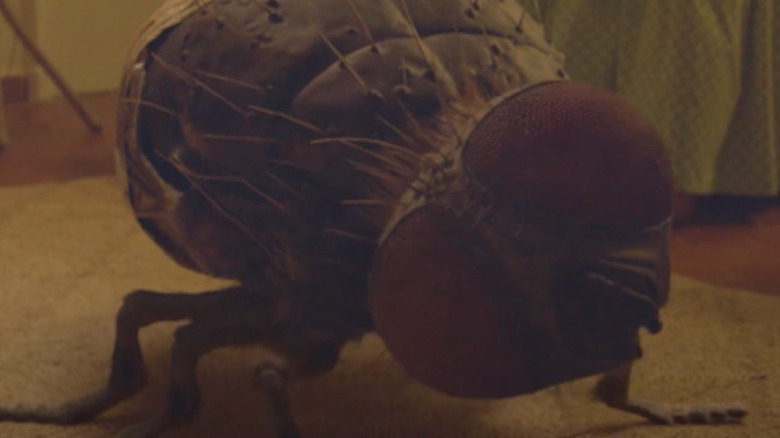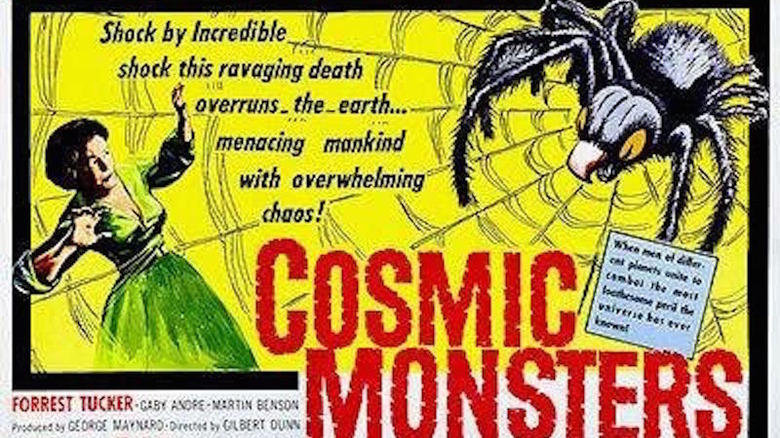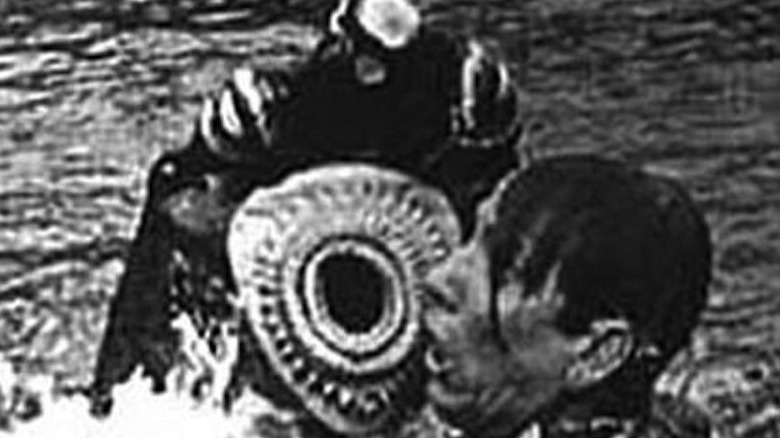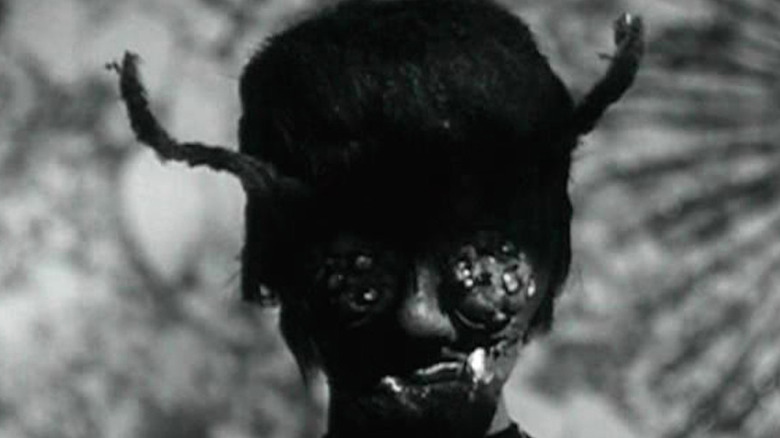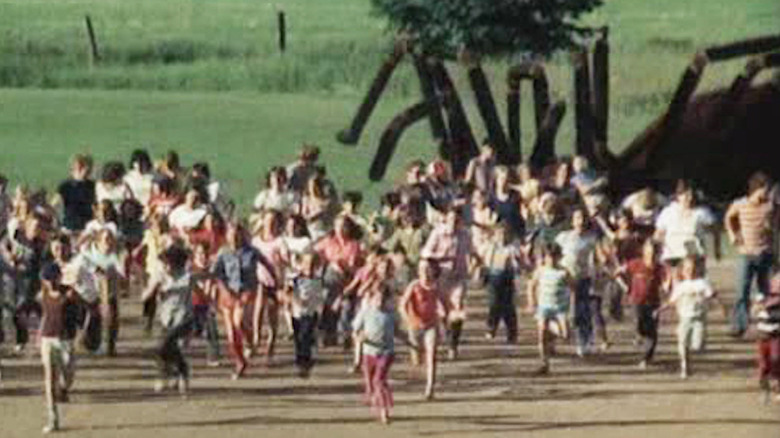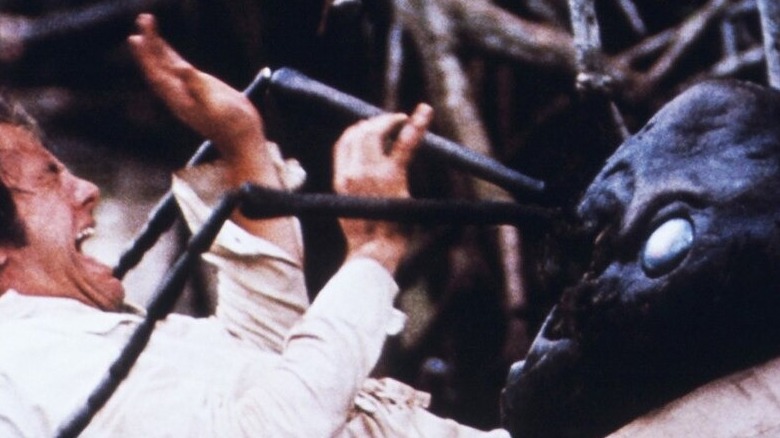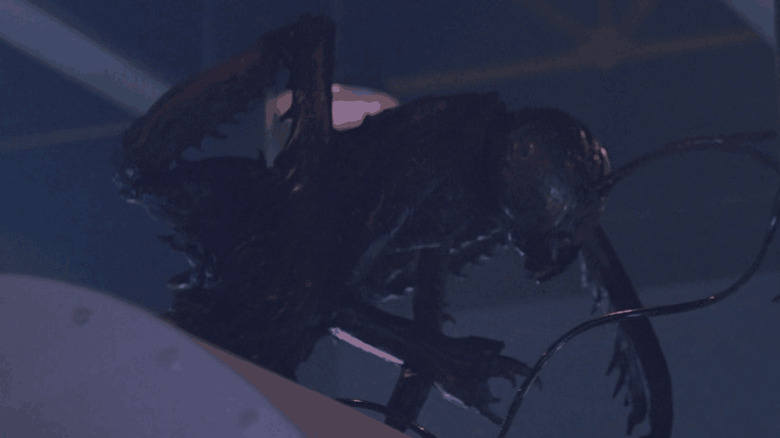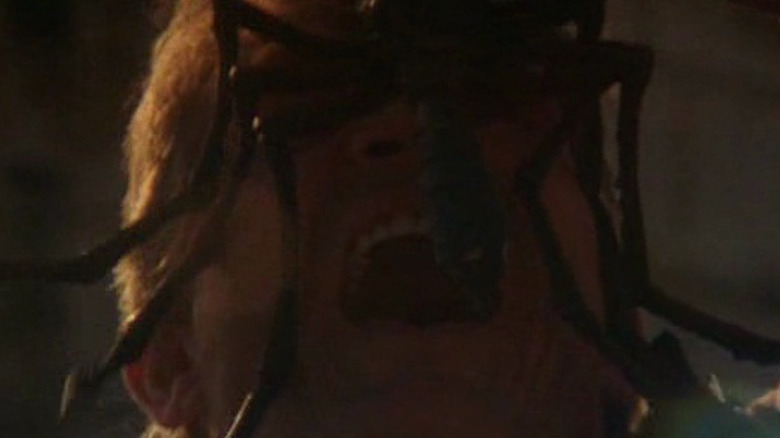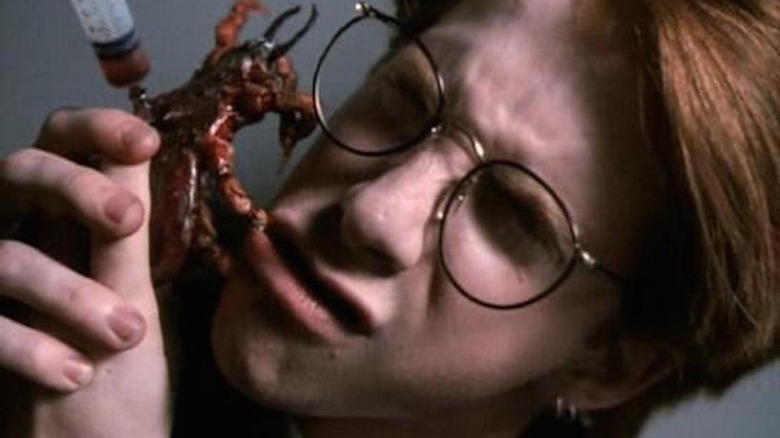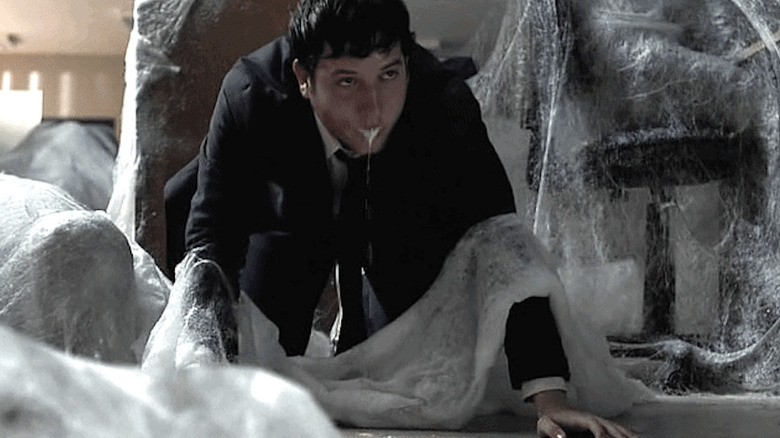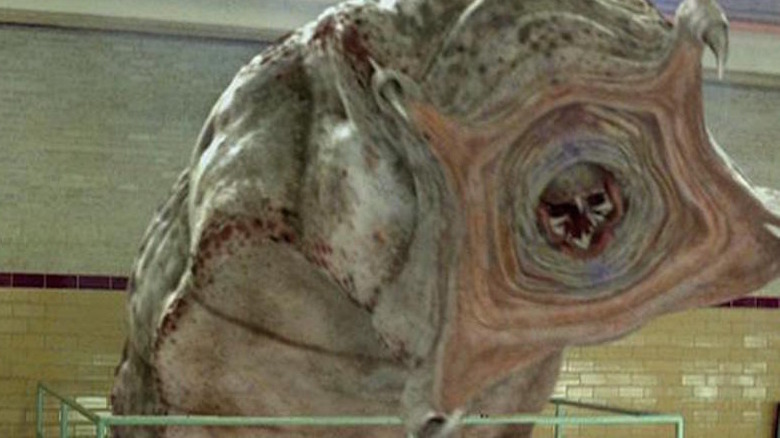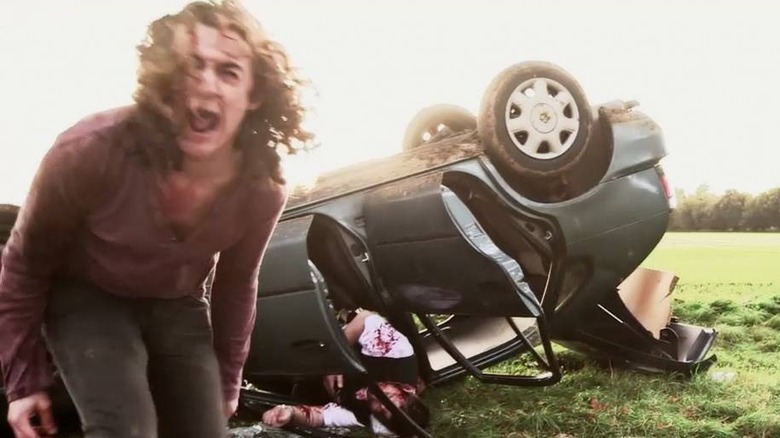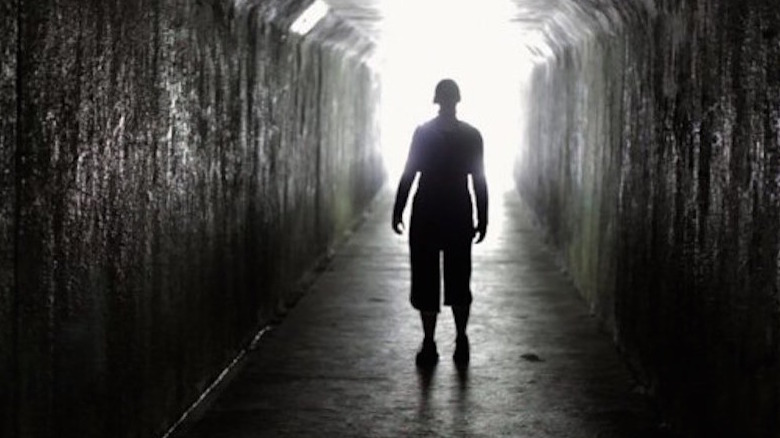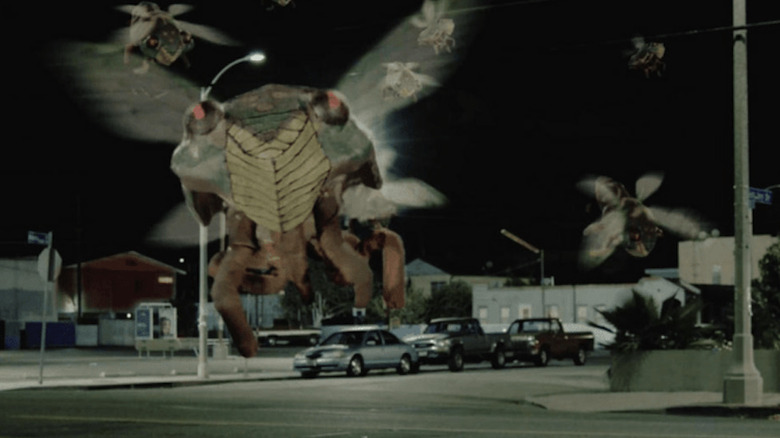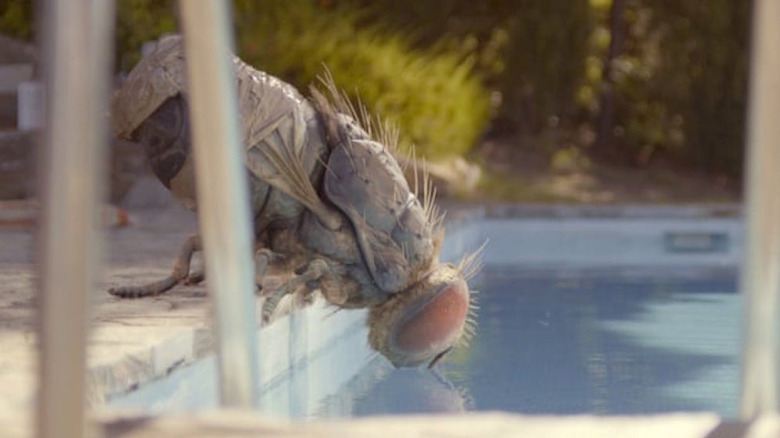Most Bizarre Big Bug Horror And Science Fiction Movies
Are you an entomophobe? Well, how do you feel about bugs? Flying bugs? Crawling bugs? Burrowing bugs? If the answer to those and other insect-related questions is a muffled scream or a fast break from the room, then chances are that you are entomophobic, or abnormally afraid of insects. Don't feel alone: it's a fairly common phobia, especially among urban residents whose exposure to bugs can be limited.
Many people are afraid of bugs to some degree, and for good reason. With very few exceptions, like butterflies, insects have traits that rub us wrong: they look weird (beetles and centipedes), they live in awful places (maggots and flies), they consider us a food source (mosquitos, fleas, gnats) and they're ruthless — destroying crops (locusts), invading homes (cockroaches), and posing a genuine threat to our well-being (scorpions, bees, wasps, etc.).
Which may be why horror and science fiction movies return, time and again, to the idea of a big bug for their monster. The dangers of science and atomic experimentation in the 1950s seemed much worse when it resulted in giant ants ("Them!") or humans with insect heads ("The Fly"), and the worst horrors of the Xenomorph in the "Alien" franchise — the whole face-hugger/chest-burster thing — mirror the activities of parasitic creatures like wasps and ticks.
Of course, not every movie big bug inspires terror in audiences. Some are just ridiculous in appearance or execution, while others originate from totally off-the-wall ideas. Below is a (spoiler-heavy) list of the weirdest big bugs to slither, flap, or scurry their way to movie stardom.
Cosmic Monsters gives us big bugs from another world
In the 1958 British sci-fi/horror film "Cosmic Monsters," scientists experimenting with magnetic fields for military purposes accidentally damage the ionosphere and let in dangerous cosmic rays. The radiation turns one resident of a small town into a lunatic and causes tremendous growth in insects, but also attracts the attention of Mr. Smith (Martin Benson), who brings a warning to humanity from a faraway place. "Cosmic Monsters" first appeared in its native country as a six-part television serial called "The Strange World of Planet X," which was also the film's UK title. Several memorable British genre titles also began as small screen projects, like "The Quatermass Xperiment" and Hammer's "The Abominable Snowman." Both of those projects were written by Nigel Kneale, who also wrote such celebrated UK TV horror projects as "The Stone Tape" and "The Woman in Black."
"Cosmic Monsters" lacks a firm hand like Kneale's behind it, but for creature feature fans, it does boast a lot of huge and creepy insects, all depicted with rear-projection images and mattes of real bugs, as well as some threadbare miniatures and props. They aren't convincing in the least, but will satisfy any nostalgic longing for old-school monster FX.
Attack of the Giant Leeches - don't call them insects
Taxonomy fans, hold your fire: yes, leeches are not insects, but rather invertebrate animals like their close cousin, the worm. But they nevertheless generate the same creeped-out feelings as many bugs, so they're included here for their high ick factor.
1959's "Attack of the Giant Leeches" certainly exploits that factor to the hilt with not one but two man-sized leeches, portrayed rather unconvincingly by two actors in costumes that resemble sleeping bags. Their look may not generate shivers, but their blood-drinking proclivities are definitely gross; director and TV veteran Bernard L. Kowalski wrings maximum disgust from the gurgling fluid sound effects and the horrified reactions of their victims, who are kept alive long enough for multiple meals.
"Leeches" was produced by drive-in movie legend Roger Corman and his brother Gene, and written by character actor Leo Gordon, who drew upon his own experience as a convicted bank robber to play dozens of bad guys in films and on TV. Gordon crafts a script that's far better than the movie, especially in its Southern Gothic subplot involving a seductive backwoods gal (Yvette Vickers) whose jealous husband (actor/director Bruno Ve Sota) uses the leeches to rid himself of her and her dopey beau.
Vanity turns a cosmetics queen into The Wasp Woman
Leo Gordon also wrote "The Wasp Woman," a cautionary tale about the dangers of vanity that also happened to feature a woman with a wasp's head. Susan Cabot starred as the head of a cosmetics firm who finds a solution for the ravages of age in a serum created from wasp enzymes. The serum works its magic on Cabot, but also periodically turns her into a half-human, half-insect monstrosity.
Roger Corman produced and directed "The Wasp Woman" with his usual mix of speed and budget professionalism. The picture marked the final feature film appearance of star Susan Cabot, who began her career in studio films and on Broadway before starring in a number of Corman productions. Mental and emotional issues forced her into seclusion in the '70s and '80s; she died in 1986 at the hands of her own son, who claimed that she had attacked him in a delusional state.
"The Wasp Woman" was remade on several occasions. Corman produced a 1995 second take with Jennifer Rubin as the cosmetics queen, and the low-budget features "Rejuvenator" and "Evil Spawn" — which was edited into a third movie, "Alien Within" — all take their cues from the plot of "Wasp Woman."
From Wisconsin It Came: The Giant Spider Invasion
Enormous spiders from outer space threaten faded film and TV stars in 1975's "The Giant Spider Invasion," a threadbare but amusing big bug feature lensed in Wisconsin by writer-director Bill Rebane. Said spiders emerge from a black hole left after a meteor crashes to Earth (yes, that is nonsensical from a science standpoint) and grow to considerable size while pursuing and devouring the residents of a rural town. Former Western heavy Steve Brodie, Barbara Hale (co-star of the original TV "Perry Mason") and the Skipper himself, Alan Hale, Jr., do their best to remain off the menu for the biggest spider, which is clearly a metal frame over a compact car.
"The Giant Spider Invasion" is probably the best known of Rebane's films, all of which were filmed in America's Dairyland. Running a close second is most likely "Monster-a-Go-Go," a movie he abandoned in 1966 that was later stitched together with stock footage (and rendered completely incomprehensible) by fellow exploitationer Herschell Gordon Lewis.
The Empire of the Ants is no picnic
1977's "Empire of the Ants" stars a pre-"Dynasty" Joan Collins as a real estate agent who lures a boatload of potential clients to a remote island with the promise of easy money through beachfront property. What the passengers don't know is that the land is already occupied — by ants made huge via abandoned toxic waste. Collins leads the survivors to a small town, only to discover that the queen ant is using pheromones to control the residents and take control of its sugar factory (!).
Produced by drive-in movie factory American International Pictures (which also released "Giant Leeches"), "Empire of the Ants" was the third adaptation of a H.G. Wells story by director Bert I. Gordon in the 1970s (the others being "The Food of the Gods" and "The Island of Dr. Moreau"). Gordon made his name in the 1950s with horror and science fiction based on outsized people and creatures, including "The Amazing Colossal Man," "Earth vs. The Spider," and "Beginning of the End," which pitted Peter Graves against Cadillac-sized locusts.
Gordon also supervised the special effects for all of his films, which made frequent use of process shots involving enlarged images of real insects that were matted into live-action footage of the actors. He employed this technology, which looked cheap and unreal in 1959, for "Empire of the Ants," along with large, stiff rubber ant models for scenes in which the ants had to attack the cast. In both cases, the effects are ludicrous.
It's called Blue Monkey, but it's about a big bug
The 1987 Canadian creature feature "Blue Monkey" offers two terrors for the price of one: you get an enormous parasitic insect that also happens to carry a horrible infectious disease. One thing to note, however: there is no monkey in this movie, blue or otherwise. The title comes from a line uttered by a quartet of kids in a hospital that accidentally feeds growth hormone to a hoagie-sized larva that has sprouted from an elderly patient's mouth.
The larva grows into an aggressive, carnivorous roach/mantis hybrid that stalks the oddly cavernous halls of the hospital (and its subterranean catacombs — seems that the hospital used to be an asylum). All of the film's characters set out after the bug, including cop Steve Railsback, medico Gwynyth Walsh (B'Etor from "Star Trek: The Next Generation"), and those dopey kids, who at one point, pause to question what they're looking for. A blue monkey is the most reasonable answer, giving the kids a purpose and the movie a title.
Scripted with greater attention to character and dialogue by George Goldsmith (the '84 "Children of the Corn") and an uncredited Chris Koseluk than a movie about a huge insect should receive, and helmed with care by eclectic Canadian director William Fruet, "Blue Monkey" is an underrated addition to big bug cinema. It's been impossible to see on home video since the VHS days, but a Blu-ray is slated for release in 2021.
Skeeter will scratch your big bug horror itch
Toxic waste is the culprit behind more big bugs in 1993's "Skeeter." The sludge, culled from an abandoned mine by bad guy developer Jay Robinson, causes mosquitos to grow to the size of chihuahuas and attack the residents of a small Southwestern town. Standing in their flight path is heroic deputy Jim Youngs and environmental agent William Sanderson, of "Deadwood" and "Newhart" fame.
'70s film and TV actor Clark Brandon directed "Skeeter" with what might be charitably called an unsteady hand: the film often wavers from broad comedy to horror within the same scene, and the professionalism of the actors is the only binding agent that keeps the picture together. The cast is a cult movie devotee's dream: in addition to Sanderson, Charles Napier ("The Silence of the Lambs") is on-hand as a corrupt sheriff, while Michael J. Pollard (an Oscar nominee for "Bonnie and Clyde") does his usual oddball routine. George "Buck" Flower, who appeared in John Carpenter's "The Fog" and "They Live," is a local yokel, while John F. Goff, whose writing and acting credits include numerous exploitation titles, is the dad of female lead Traci Griffith ("Sleepaway Camp III"). Attempting to hold the whole thing together is co-producer Don Edmonds, director of the notorious "Ilsa: She-Wolf of the SS."
As for the skeeters? Well, they're ratty-looking puppets whose primary means of flight appears to be courtesy of an off-camera production assistant throwing them at actors. They do splat with impressive gore, though.
Seth Green battles different bloodsuckers in Ticks
Yes, science fans, ticks are not bugs, but rather members of the mite family (which in turn, is part of the larger arachnid class). But their penchant for burrowing into warm flesh and drinking blood more than qualify them as bad bugs — a fact which the 1993 direct-to-video horror feature "Ticks" plays to the hilt.
The ticks in director Tony ("Hellbound: Hellraiser II") Randel's film are roughly the size of a soccer ball — the result of experimental steroids used by rogue marijuana growers like cult favorite Clint Howard, who learns the hard way about ticks' feeding habits. The Oscar-winning KNB EFX Group ("The Walking Dead") provides appropriately gooey special effects and creepy creature models, which the cast — led by Seth Green, who's joined by Ami Dolenz and Alfonso Ribero — do their best to avoid.
Unanswered questions and plot holes abound in "Ticks" — like Seth Green's sort-of psychic abilities — but why quibble when the film offers the sight of a tick bursting from the chest of Alfonso Ribero?
Can a slacker save us from an alien bug Infestation?
In 2009's "Infestation," hapless office worker Chris Marquette is saved from termination at his dead-end office job when he and everyone around him loses consciousness. Upon waking up, he discovers many his co-workers wrapped in webbed cocoons and enormous, housefly-like bugs preying on the others. Marquette joins forces with his hard-boiled dad (the great Ray Wise), his boss's daughter (Brooke Nevins), and a gaggle of oddballs to mount a defense again the bug menace.
Written and directed with tongue firmly in cheek by Kyle Rankin, who survived the second round of the "Project Greelight" reality series, "Infestation" is a goof, but an entertaining one thanks to Marquette's easygoing performance and some amusingly gloppy confrontations with the bugs, which develop the ability to merge with other lifeforms and create hideous/ridiculous mutations.
The effects are deliberately silly and lo-fi — the bugs, when struck, spew copious amounts of what appears to be dessert topping — which only adds to the loopy appeal of "Infestation."
Hey, a new Tremors movie? No, just Mongolian Death Worm
The Mongolian death worm, or olgoi-khorkhoi, is a popular creature in cryptozoological circles. It's described as a large, sand-dwelling worm that resides in East Asia's Gobi Desert and possesses the ability to spit acid and create a lethal electrical current. Several expeditions and TV documentaries have attempted to turn up evidence of the creature, all without conclusive results. However, the Mongolian death worm did get its moment of pop culture stardom in 2010, thanks to an eponymous TV-movie from SyFy.
The state of Texas stands in for Mongolia in director Steven R. Monroe's film; it's a completely unconvincing substitute, but not quite as underwhelming as the worms themselves. Loosed from their desert homes by an American oil company, the creatures look like second-rate CGI knockoffs of the graboids from the "Tremors" franchise. They also lack the ability to spit acid and throw lightning, but can emit an electromagnetic pulse that disables machinery.
As the film's treasure hunting hero, Sean Patrick Flanery does his best to keep a straight face as he pretends to battle the cut-rate creatures. He's successful — mostly.
Hungerford is an ambitious indie invasion movie
UK filmmaker Drew Casson was in his late teens when he directed and starred in the 2014 found footage horror film "Hungerford." Casson plays a small-town English teenager whose school project—– recording a week in his life with a video camera — turns into a documentary about an alien invasion of the United Kingdom. The extraterrestrials — who remain off-screen for most of "Hungerford" — use oversized insect-like creatures to carry out their plan; the creatures burrow into the necks of their victims and control their actions, which turn from self-destructive to homicidal.
Casson invests a considerable amount of suspense and special effects into "Hungerford," which is impressive, given the film's amateur origins. Critical praise for the film led to additional films from Casson, including "Darkest Dawn," a 2016 sequel to "Hungerford" which observed the alien's world domination plans from the perspective of two sisters — again, armed with video cameras — and survivors from the previous film.
Mike Flanagan mixed folklore and big bugs in Absentia
Prior to establishing his name in the horror field with "Oculus," "Doctor Sleep," and "Midnight Mass," writer/director Mike Flanagan turned to crowdfunding for his second post-college feature film. "Absentia," which was released direct to video in 2011, follows a woman (Katie Porter) who comes to believe that her long-missing husband (Morgan Peter Brown) is not only alive, but also under the sway of creatures living in the tunnels beneath Glendale, California. Said creatures, which Flanagan suggests are like the trolls of myth and folklore, suggest more insect than humanoid.
Flanagan keeps his cards close in regard to whether the signs that Porter is receiving about her husband are real or the product of her grief and stress. Any sense of ambiguity about the creatures — and their interest in humans — is made chillingly clear in the film's final third. Here, Flanagan evokes another long-standing myth about trolls and other creatures that live in dark places: they'll agree to a barter, but you might end up with something terrible in the trade.
Batter up for splatter in the mockbuster Cicada!
Experimental fertilizer transforms cicadas — the burrowing, chattering bugs that emerge from the ground every 17 years — into huge, bloodthirsty killers with explosive properties in 2018's "Cicada!" a deliberately silly sci-fi/horror pic from writer-director David Willis. The micro-budgeted creature feature, which was shot over the course of 15 days, pits a disgraced baseball player (co-producer Jeffrey Ryan Kent) against the oversized insects as they prey upon hapless Los Angeles residents.
Willis spares no quarter in playing up the film's cornball elements: the visual effects are rendered with the crummiest CGI possible or with obvious models, including a few cicadas on the end of visible wires and a toy helicopter. The laughs are broad and designed to offend, and the gore is plentiful. Your tolerance for endless explosions, splattering CGI bugs, and goofball humor will determine how much you enjoy "Cicada!" but if your taste in terror leans towards backyard epics and mockbusters, you'll find it — for better or worse — in abundance.
Two losers befriend a giant fly in Mandibles
Were you to discover a housefly the size of a cocker spaniel, what might your reaction be? Disgust? Terror? Panic? All are natural responses — unless, of course, you are the dim heroes of French director Quentin Dupieux's 2020 film "Mandibles." Upon finding such a fly in the trunk of their car, Manu (Gregoire Ludig) and Jean-Gab (David Marsais) — neither of whom are, as the saying goes, the sharpest knives in the drawer — briefly express bewilderment before hatching a plan. They'll use Dominique (the name they give the fly) to rob banks. If that sounds foolish and disastrous to you, congrats: you're right.
With "Mandibles," Dupieux carries forward the totally bizarre notions behind two of his best-known films: "Rubber," which details a terror campaign carried out by an apparently sentient spare tire, and "Deerskin," in which a man (Oscar winner Jean Dujardin) is driven to madness by his obsession with a magical deerskin jacket. Dominique — which is an impressive special effect — is more animated and sympathetic than the tire in "Rubber," but still possesses a strange, if totally unconscious power to inspire people to take extreme actions.
You can read all sorts of messages into "Mandibles" — our ability to forge connections with objects or things but not with our fellow humans, for one — or you can simply enjoy it as a curious comedy about two dopes and their new friend, a giant fly.
